The Pnyx is a hill in central Athens, Greece. It is situated west of the Acropolis and between the hills of Philopappos and Nymphon. It bears paramount historical significance as the site that hosted the Ecclesia: the popular assembly of the ancient Athenians. Thus it may be considered as the cradle of Democracy and the Western Civilization’s political values. Evidence of its glorious past survives today atop the hill in the form of archeological ruins. The entire territory of the Pnyx Hill is designated a municipal park and its slopes are forested with pines, cypresses, and other endemic vegetation. Other than sightseeing, one may here enjoy a pleasant stroll or run, and some splendid views to the Acropolis and the rest of Athens.
Contents
- Quick Facts
- Description
- Eytmology
- History
- Contemporary Sights
- Bema (Orator’s Podium)
- Themistoclean Wall and Diateichisma
- Retaining Wall
- Sanctuary of Zeus Hypsistos
- Meton’s Solar Clock
- Sanctuary of Pan
- Pnyx Fountain
- Observatory
- Brick Pillar
- How to get there
- Entrance Fee
- Opening Hours
- Map
- Photo Gallery
Quick Facts
- Coordinates: 37.9714, 23.7194
- Area: 0.110 km2
- Elevation: 109 meters
- Closest metro station: Thission
- Cost: None
- When to visit: Open 24/7, early and late day hours best to avoid heat and take nice pictures
- What to see: Grounds of ancient Athens’ popular assembly, ancient fortification works, ancient solar clock, views of the Acropolis
- What to do: Sightseeing, stroll, jogging, picnic
Description
The hill of Pnyx covers an area of roughly 0.110 km2. It is adjoined by Philopappos Hill at its southern foot and Nymphon Hill on its north. Its eastern foot neighbors Apostolou Pavlou pedestrian street, after which rise the hills of Areopagos and the Acropolis. To the west, it borders Stisikleous Street and Petralona District. The Pnyx is accessible by numerous paths all along its periphery.
Much of the hill is covered with pines, cypresses, olive trees, eucalypti, and various kinds of local trees and shrubs. Numerous paved paths and dirt tracks run all across its territory. Below the eastern side of its highest point, there is an extensive, rather flat rocky area that was used for the popular assemblies of the ancient Athenians.
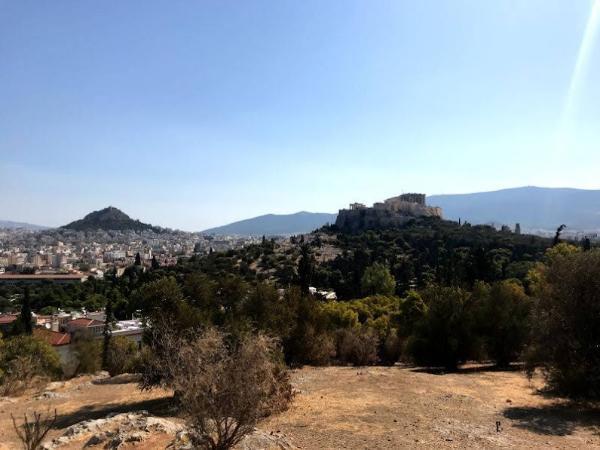
Accommodation and Activities in Athens
Stay22 is a handy tool that lets you search for and compare stays and experiences across multiple platforms on the same neat, interactive map. Hover over the listings to see the details. Click on the top-right settings icon to adjust your preferences; switch between hotels, experiences, or restaurants; and activate clever map overlays displaying information like transit lines or concentrations of sights. Click on the Show List button for the listings to appear in a list format. Booking via this map, I will be earning a small cut of the platform's profit without you being charged any extra penny. You will be thus greatly helping me to maintain and keep enriching this website. Thanks!
Greek Word Meaning & Pronunciation
The word Pnyx (ancient Greek: Πνύξ) is believed to be derived from the adjective πυκνός (pyknos), meaning dense. According to this etymological theory, the hill came to be called so owing to the large concentrations of people that gathered there to attend the popular assemblies. The word is pronounced like pnýks. In modern Greek, just like with all 2nd- and 3rd-declination feminine nouns, the accusative form of the word has absorbed the nominative case as well; thus Greeks will refer to the site as Pnyka (Πνύκα) instead of Pnyx.
History
Archeological research supports the theory that the Pnyx was used as a site of religious rituals since the very foundation of the city of Athens, as far back as the 4th millennium BC.
In mythology, together with the adjoining hill of Philopappos, the site was the battleground where the Athenians repelled the attack of the Amazons. Throughout historic times, the hill was an important part of Athens’ fortifications network.
The hill acquired preeminent significance when, sometime in the early 5th century BC, shortly after the reforms of Cleisthenes and the foundation of the Athenian Democracy in 508 BC, the gathering place of the Ecclesia (popular assembly) was moved there from the Agora of Athens. The reason for this relocation was probably related to sheer area. According to some scholars, as many as 13,000 citizens could gather there to attend the assembly. The hill then came to be given its current name, owing to the large crowds of people that assembled there.
The history of the Pnyx as the forum of the Athenian Democracy may be divided into three principal phases
- The first phase lasted for the first few decades of Pnyx’s democratic history in the 5th century BC. This chapter is evinced archeologically only by a few minor bedrock cuts, and we owe our knowledge of it mostly to ancient literary sources. The audience then sat on the hillside facing an orator’s podium on the north and having a view of the Agora below. Wooden seats were in place for the 500 members of the council.
- The second phase began in the late 5th century BC and lasted until the second half of the 4th century. This stage, too, is known to us more from literary sources rather than archeological ones. The orientation of the auditorium was completely reversed, so that the audience faced towards a podium on the south. An artificial terrace was constructed to seat the attendants. Parts of the terrace’s supportive wall survive today. The total area of the auditorium was only slightly larger than during the first phase.
- The third phase, which gives Pnyx its current form, began in the second half of the 4th century BC, probably between 334-335 BC. A bulky retaining wall was then built on the north side and the southern portion of the auditorium. together with the speaker’s platform, were carved out of the natural rock. The construction of two stoas began on a terrace above the podium but was apparently never completed.

By the 1st century BC – perhaps earlier – the Pnyx was abandoned altogether as the site of the popular assemblies and was replaced by the Theater of Dionysos on the southern slope of the Acropolis. The hill was then turned into a place of worship, hosting a sanctuary of Zeus Hypsistos.
Excavations began in 1910 and continued through the 20th century to gradually reveal various archeological remains.
Contemporary Sights
Here is a list of the most notable archeological and modern sights found on the hill of Pnyx today.
Bema (Orator’s Podium)
The Bema (Greek for podium) is the most important sight of Pnyx: a stone platform whence Pericles, Alcibiades, Aristides, Demosthenes, and many an eminent Athenian orated before crowds of thousands.
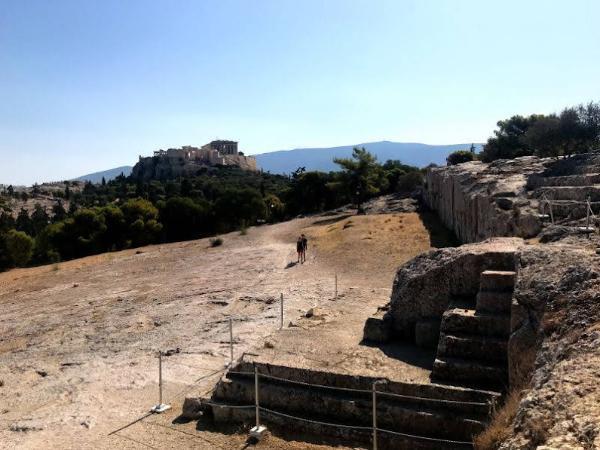
Themistoclean Wall and Diateichisma
Parts of the fortification works of ancient Athens survive on the hill of Pnyx. Some belong to the Themistoclean Wall, constructed after the end of the Persian Wars in the 5th century BC. Others belong to the Diateichisma: a posterior appendage constructed in the late 4th century BC.
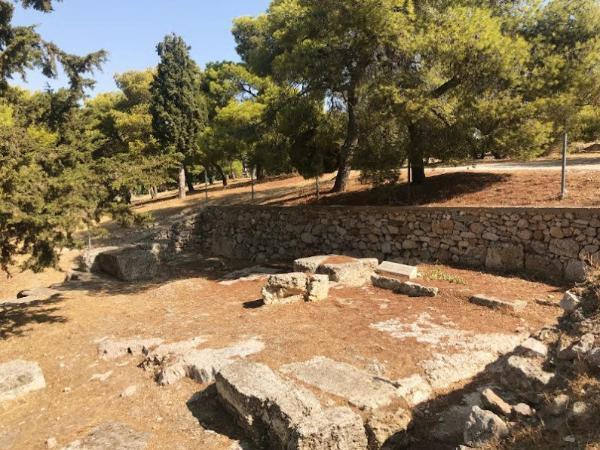
Retaining Wall
A portion of a large, stone-block, supportive wall, built during the third-phase reconstruction of the Pnyx in the late 4th century. It is seen right upon entering the park from its north gate.
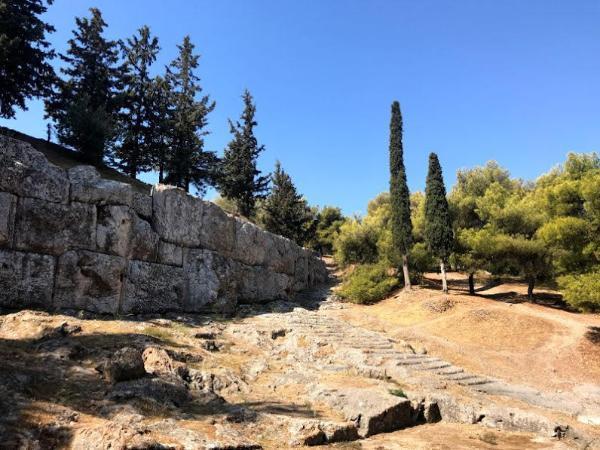
Sanctuary of Zeus Hypsistos
The foundations of an altar, as well as wall-carved niches for offerings to Zeus Hypsistos, are visible on the grounds of the ancient auditorium.
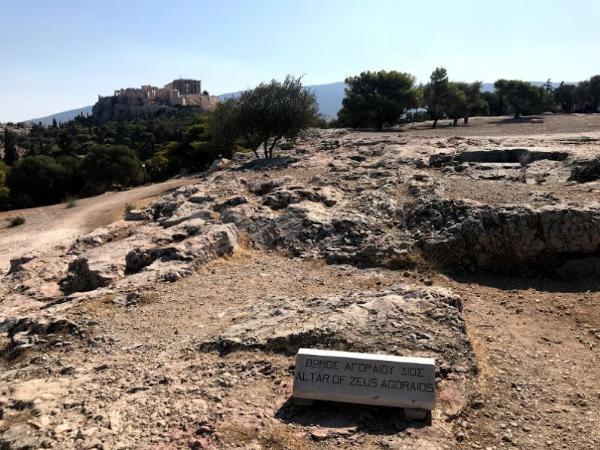
Meton’s Solar Clock
In spite of what its name suggests, Meton’s Solar Clock was much more than a time-telling device. Known as helioscopion (not to be confused with modern astronomical helioscopes), that was a cubic tower used by ancient astronomers to finely determine and project the positions of the sun, moon, and other celestial objects. Utilizing this instrument, which he personally designed, astronomer Meton discovered the 19-year periodicity of the moon’s cycle, known today as the Metonic Cycle in his honor. Unfortunately, only the foundation of the tower remains.
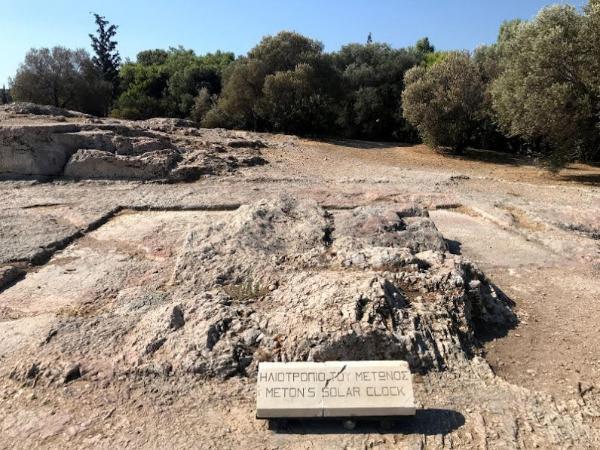
Sanctuary of Pan
At the northeastern foot of the hill, seen from Apostolou Pavlou Street, carved in the natural bedrock, lies a sanctuary of Pan, God of wine and feasting.
Pnyx Fountain
A few meters south from the Sanctuary of Pan, also seen from the street, there is an artificial cave formed as a fountain. It seems to be related to the wide-scale works of Athens’ water supply that were undertaken in the years of Peisistratos, 6th century BC.
Observatory
By the north end of Pnyx Hill, facing the main observatory atop the neighboring Nymphon Hill, stands a smaller, modern astronomical observation unit.
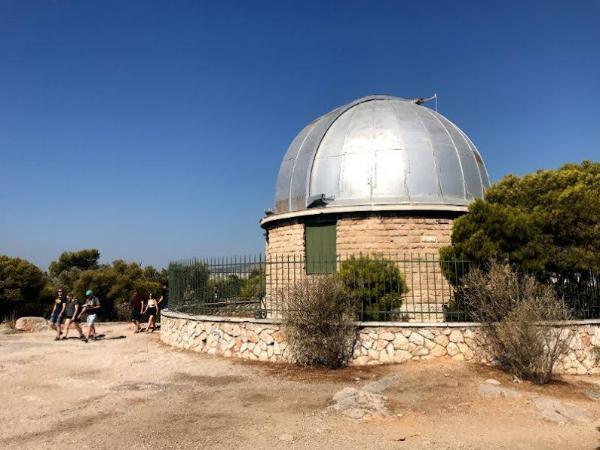
Brick Pillar
By the side of that small observatory stands a short chimney-shaped brick pillar. I couldn’t figure out or find any information about its purpose, but it is pretty picturesque with the Acropolis in the background.
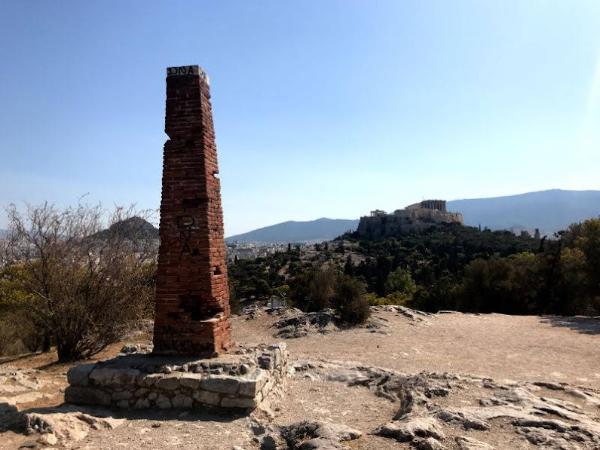
How to get there
- From Thission Metro Station, walk south on Apostolou Pavlou Street for about half a kilometer. Turn right on Dimitriou Aiginitou Street, as soon as you encounter the park fence, 50 meters after Cine Thission movie theatre. Keep straight for some 80 meters. You will see the entrance on your left hand.
- From Acropolis Metro Station, walk south on Apostolou Pavlou Street for about a kilometer. Turn left on Dimitriou Aiginitou Street, as soon as the park fence ends. Keep straight for some 80 meters. You will see the entrance on your left hand.
- From Petralona Metro Station, follow Thessalonikis Street north for 400 meters, having the railway on your left. Take a right on Pallineon Street (Nicol clothes store stands at the corner). Follow uphills until the end of the street and onwards along the path for another 40 meters. Turn left on Stisikleous Street and follow north for 300 meters along with the fence on your right hand. You will see a gate whence a stone stairway begins ascending the hill.
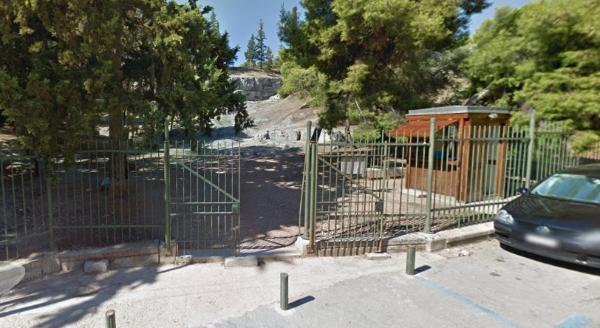
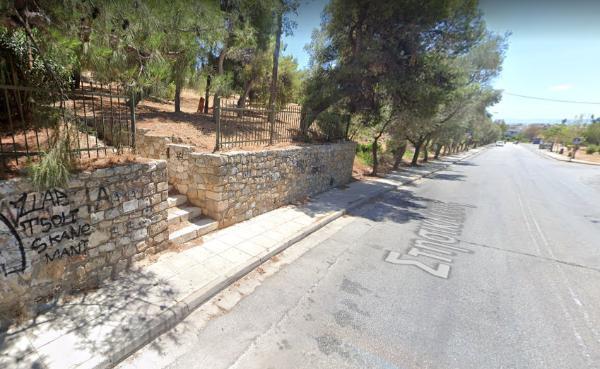
Entrance Fee
No entrance fee applies to access the area of the Pnyx Hill. It is designated a municipal park.
Opening Hours
Although the park used to be closed at night some years back, to my best knowledge it currently remains open 24 hours, all year round.
Map
Photo Gallery
View (and if you want use) all my photographs from Pnyx Hill.
